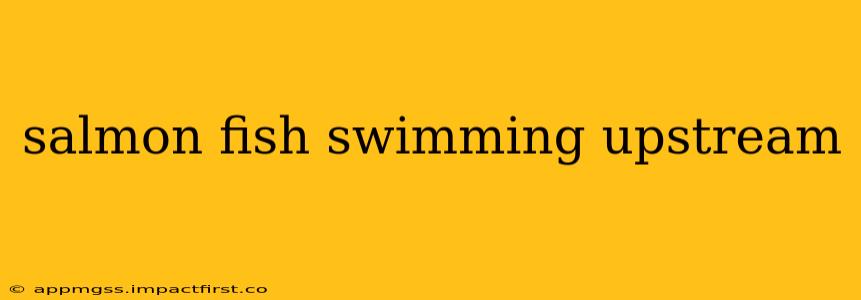The image of salmon battling their way upstream is iconic. It represents perseverance, strength, and the incredible power of instinct. But what exactly drives these fish on their arduous journeys, and what challenges do they face? This article delves into the fascinating world of salmon migration, exploring the reasons behind this epic undertaking and the obstacles they overcome.
Why Do Salmon Swim Upstream?
Salmon's upstream journey is primarily driven by an innate reproductive instinct. They are anadromous fish, meaning they are born in freshwater, migrate to the ocean to mature, and then return to their natal streams (the exact stream where they were born) to spawn and reproduce. This incredible homing ability remains one of nature's greatest mysteries, though scientists believe a combination of olfactory cues (smell) and geomagnetic sensing plays a crucial role. Essentially, they're programmed to return to the very spot where their life began.
What Challenges Do Salmon Face Swimming Upstream?
The journey upstream is fraught with peril. Salmon face numerous obstacles that test their physical and mental limits.
Strong Currents and Rapids: Navigating powerful currents and cascading rapids requires immense strength and stamina. They use their powerful tails to propel themselves against the flow, often leaping over obstacles in a spectacular display of agility.
Predators: Salmon are vulnerable to predation throughout their upstream journey. Bears, eagles, otters, and other fish are just some of the predators that lie in wait, ready to ambush these energy-rich fish.
Waterfalls and Dams: Waterfalls and man-made dams represent significant barriers to salmon migration. While some salmon can successfully navigate smaller waterfalls, larger obstacles often prove insurmountable, leading to significant mortality. Dams, in particular, have drastically altered salmon migration routes and populations worldwide.
Human Impact: Pollution from agricultural runoff, industrial waste, and urban development also significantly impact salmon populations. These pollutants can degrade water quality, harming salmon eggs and young fish, and reducing the overall success of their upstream migration.
How Do Salmon Overcome These Challenges?
Salmon's success in navigating these challenges relies on several remarkable adaptations:
- Powerful Muscles: They possess exceptionally strong muscles, particularly in their tails, allowing them to propel themselves against strong currents.
- Sharp Senses: Their keen sense of smell helps them locate their natal streams, even after years spent in the ocean.
- Physiological Changes: During their migration, salmon undergo significant physiological changes. For example, their bodies undergo a transformation allowing them to survive in freshwater after extended periods in saltwater.
- Instinct and Determination: Their innate drive to reproduce is a powerful force, pushing them to overcome incredible odds.
What Happens After Salmon Reach Their Spawning Grounds?
Once they reach their spawning grounds, female salmon dig nests (redds) in the gravel bed of the stream. They then lay their eggs, which are fertilized by the male salmon. After spawning, most salmon die, completing their life cycle. The young salmon will then hatch and begin their journey to the ocean, repeating the cycle.
How Can We Help Protect Salmon Populations?
The survival of salmon populations faces significant threats due to human activity. Protecting these incredible creatures requires collaborative efforts:
- Dam Removal and Fish Ladders: Removing obsolete dams and installing fish ladders can help restore migration pathways.
- Improved Water Quality: Reducing pollution through better agricultural practices and industrial regulations is crucial.
- Habitat Restoration: Protecting and restoring riparian habitats (areas along rivers and streams) provides crucial shelter and spawning grounds.
- Sustainable Fishing Practices: Implementing sustainable fishing regulations is essential to prevent overfishing.
The salmon's journey upstream is a testament to the power of nature. By understanding the challenges these fish face and implementing conservation strategies, we can help ensure the continued survival of these incredible creatures for generations to come.
